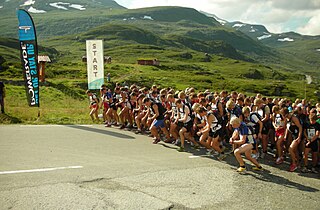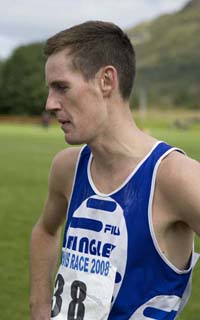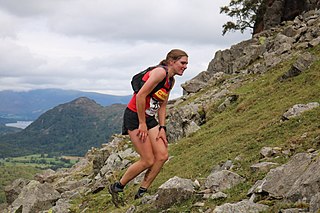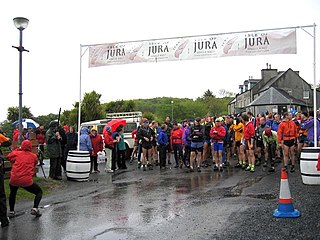Related Research Articles

Fell running, also sometimes known as hill running, is the sport of running and racing, off-road, over upland country where the gradient climbed is a significant component of the difficulty. The name arises from the origins of the English sport on the fells of northern Britain, especially those in the Lake District. It has elements of trail running, cross country and mountain running, but is also distinct from those disciplines.

Robert Jebb is an English fell runner, skyrunner, and cyclo-cross rider. He has won the annual Three Peaks Cyclo-Cross in the Yorkshire Dales a record twelve times since 2000, is a four-time-winner of the Three Peaks Race in the same region and broke Catalan dominance in the Buff Skyrunner World Series when he became champion in 2005.
Billy Bland is a British former long-distance runner. He was one of the most prominent fell runners from the mid-1970s until the late 1980s, and is arguably the best long-distance fell runner in the history of the sport.
Bill Smith was a fell runner and author on the sport. His achievements in breaking records for the number of peaks scaled within 24 hours, contributions to fell-running events, plus documenting its history, earned him the accolade of "legend" within the sport upon his accidental death in 2011. His body was discovered on 7 October in a peat bog in the Forest of Bowland, Lancashire, England, after a three-week disappearance.
Colin Kerr Donnelly is a Scottish runner who was the British fell running champion three times and finished second in the World Mountain Running Trophy.
John Richard Wild is a male English former runner who competed in cross country, fell running, and the 3000m steeplechase.
Gavin Bland is a British fell runner who was a British and English champion and represented his country at the World Mountain Running Trophy.
Ros Evans is a British athlete who competed in fell running, orienteering, ski-orienteering and cross-country skiing. She is also mother to British track cyclist, Neah Evans.

Robert Hope is an English runner who has been a national fell running champion several times and who has represented his country at the World Mountain Running Trophy.

The Borrowdale Fell Race is an annual fell race held in August, starting and finishing in Rosthwaite. It is considered to be one of the "classic" Lakeland races and the route initially heads over Bessyboot before climbing England's highest summit, Scafell Pike. Great Gable is then scaled before a descent to Honister Pass and the final climb up Dale Head. The distance is approximately seventeen miles and the route has around 6,500 feet of ascent.

Simon Booth is an English runner who was twice the British fell running champion and who has represented his country at the World Mountain Running Trophy.
The Wasdale Fell Race is an annual Lake District fell race held in July, starting and finishing at Brackenclose in Wasdale. The course is approximately twenty-one miles long with around 9,000 feet of ascent and takes in checkpoints at Whin Rigg, Seatallan, Pillar, Great Gable, Esk Hause shelter, Scafell Pike and Lingmell nose wall. The route between Pillar and Lingmell is very rough, with steep technical ground and boulder fields. Among long fell races, Wasdale has one of the highest ratios of feet of ascent per mile, and it is often considered to be the toughest of the British races.

The Langdale Horseshoe is an annual Lake District fell race that starts and finishes at the Old Dungeon Ghyll. The course climbs to Stickle Tarn before heading to Thunacar Knott, Esk Hause shelter, Bowfell, Crinkle Crags and Pike of Blisco. The route is approximately 21 kilometres (13 mi) in length with 1,450 metres (4,760 ft) of ascent. It includes much rough and rocky ground. On the descent from Crinkle Crags, many runners negotiate the Bad Step, although it can be avoided depending on route choice. The race often presents navigational difficulties, especially in poor visibility.

Jasmin Karina Paris is a British runner who has been a national fell running champion and who has set records for the Bob Graham Round and the Ramsay Round.

The Isle of Jura Fell Race is an annual fell race held in May, starting and finishing at Craighouse on the Scottish island of Jura. The course loops west and north over several hills including the Paps of Jura. After the last climb to Corra Bheinn, a boggy descent takes the runners down to the tarmac coastal road which is followed for the final three miles to the finish. The route is approximately 17 miles (27 km) in length, with around 2,350 metres (7,710 ft) of ascent. As well as being known for the very difficult rocky and boggy terrain involved, the race is notable for its remoteness. The journey to the start of the race typically involves a ferry journey from the Scottish mainland to Islay, followed by another ferry to Jura and then several miles by bicycle, by bus or on foot to Craighouse.

The Ennerdale Horseshoe Fell Race is an annual Lake District fell race held in June, starting and finishing at the Scout Camp near Ennerdale Water. The route is approximately 36.8 kilometres (22.9 mi) in length with 2,290 metres (7,510 ft) of ascent and takes in checkpoints at Great Borne, Red Pike, Blackbeck Tarn, Green Gable, Kirk Fell, Pillar, Haycock, Iron Crag and Crag Fell.
The Sedbergh Hills Fell Race is an annual fell running race in Cumbria, England. The race starts and finishes in Sedbergh and has a distance of approximately 22.5km and contains 1830m of ascent. It is usually run in August. The inaugural event was held in 1979. The ladies' race was held over a shorter course that year, but subsequently the women ran the same route as the men. In its early years, the race was organised by Mike Walford on behalf of Kendal Athletic Club.
Mark Alan Rigby is a British runner who was a national hill running champion and who represented Scotland in the World Mountain Running Trophy.
The Coniston Fell Race is an annual Lake District fell race held in April or May, starting and finishing in the village of Coniston. The route is approximately 14 kilometres (8.7 mi) in length with 1,065 metres (3,494 ft) of ascent and takes in checkpoints on the summits of Wetherlam, Swirl How and the Old Man of Coniston.
Pauline Stuart is a former pioneer female fell runner, being the first woman to win many of the classic fell races in the late 1970s and early 1980s, some as soon as they allowed women to enter.
References
- ↑ Bill Smith, Stud Marks on the Summits (Preston, 1985), 457-58.
- ↑ Ambleside AC: Langdale Horseshoe.
- ↑ Neil Shuttleworth, "The Record has Stood…", Up & Down, Sep/Oct 1990, 24-25; Andy Styan, "That Langdale Record", The Fellrunner, Summer 2007, 104-05.
- ↑ Lakeland Classics – Top 20 Men All Time Ranking.
- ↑ Bill Smith, Stud Marks on the Summits (Preston, 1985), 220-23.
- ↑ "Mountain Runner Shatters Record", The Times, 30 May 1983, 18.
- ↑ The Fell Runner, Summer 1979, 3-4.
- ↑ Fellrunner.org.uk: British Champions.
- ↑ The Fell Runner, Jan 1980, 5 Archived 27 January 2021 at the Wayback Machine ; The Fell Runner, Dec 1982, 3.